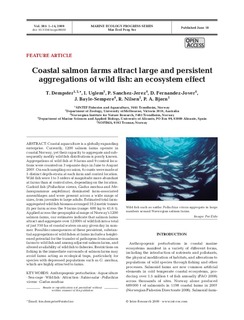| dc.description.abstract | Coastal aquaculture is a globally expanding enterprise. Currently, 1200 salmon farms operate in coastal Norway, yet their capacity to aggregate and subsequently modify wild fish distributions is poorly known. Aggregations of wild fish at 9 farms and 9 control locations were counted on 3 separate days in June to August 2007. On each sampling occasion, 6 counts were made at 5 distinct depth-strata at each farm and control location. Wild fish were 1 to 3 orders of magnitude more abundant at farms than at control sites, depending on the location. Gadoid fish (Pollachius virens, Gadus morhua and Melanogrammus aeglefinus) dominated farm-associated assemblages and were present across a wide range of sizes, from juveniles to large adults. Estimated total farm-aggregated wild fish biomass averaged 10.2 metric tonnes (t) per farm across the 9 farms (range: 600 kg to 41.6 t). Applied across the geographical range of Norway’s 1200 salmon farms, our estimates indicate that salmon farms attract and aggregate over 12000 t of wild fish into a total of just 750 ha of coastal waters on any given day in summer. Possible consequences of these persistent, substantial aggregations of wild fishes at farms include a heightened potential for the transfer of pathogens from salmon farms to wild fish and among adjacent salmon farms, and altered availability of wild fish to fisheries. Restrictions on fishing in the immediate surrounds of salmon farms may avoid farms acting as ecological traps, particularly for species with depressed populations such as G. morhua, which are highly attracted to farms. | no_NO |
